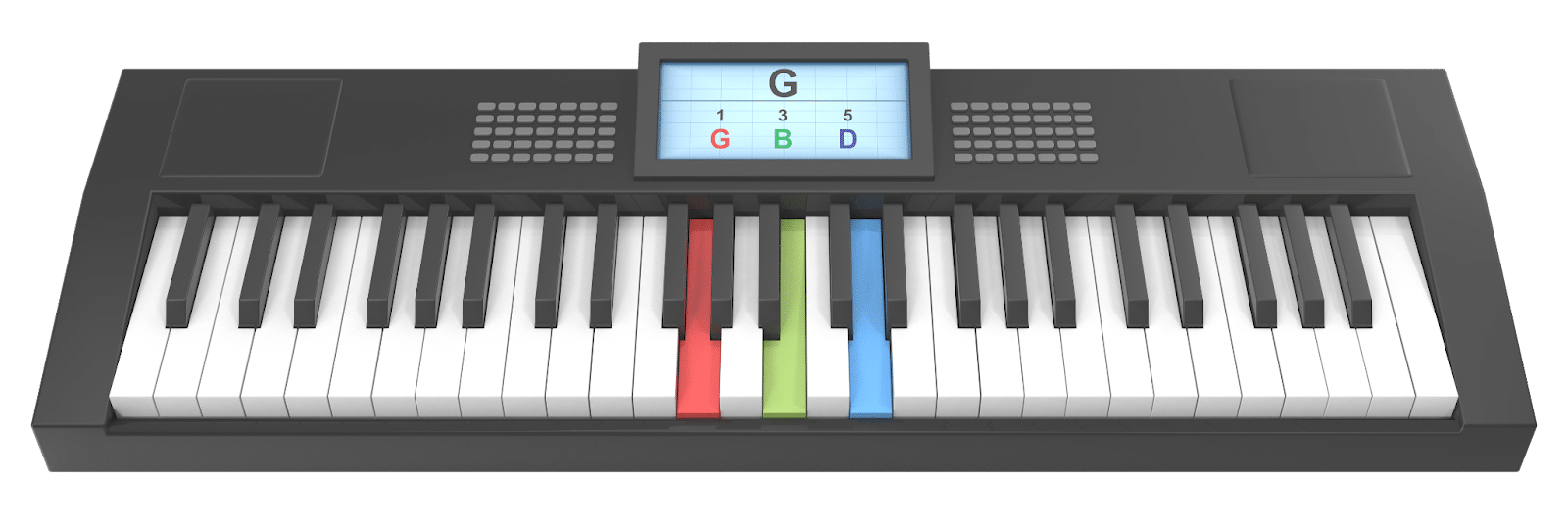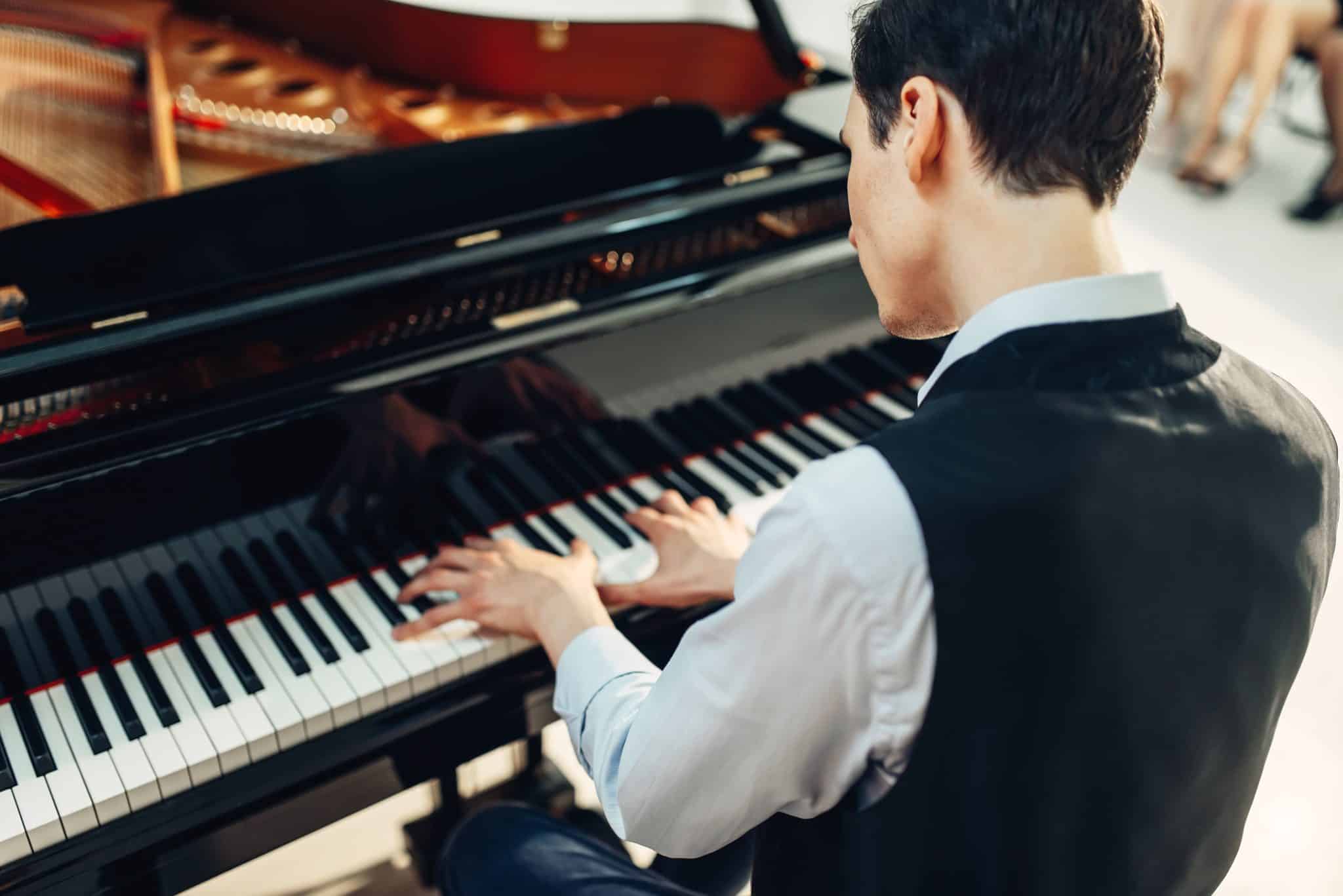When learning to play the piano, starting with simple, foundational chords is key.
One of the most important chords you’ll encounter is the G major chord. It’s versatile, widely used in many songs, and a great starting point for beginners.
Whether you’re just starting out or looking to refine your skills, understanding how to play the G chord is essential.
In this guide, we’ll break down everything you need to know about the G chord, why it’s so important, and how to play it.
If you’re interested in a deeper dive into learning piano, including intuitive ear training, check out our “My Piano by Ear” course—designed to help you play the music you love, even without sheet music. It’s free to get started!

How to Play the G Chord on Piano
Now, let’s dive into the steps to play the G chord on the piano.
- Find the Notes:
- Locate the G note, which is the white key immediately to the right of the first black key in any group of three black keys. (Red note in diagram above)
- Move up to the B note, (counting black and white keys) four keys higher than G. (Green note in diagram above)
- Then, move up three keys (counting black and white keys) from B to find the D note. (Blue note in diagram above)
- Position Your Fingers:
- Place your thumb on G.
- Place your middle finger on B.
- Place your pinky on D.
- Play the Chord: Press down on G, B, and D simultaneously. Make sure each note sounds clearly without any buzzing or muffled sound.
- Practice: The faster you play a note, the more it sounds. So if you want to play a note louder, you must play the key faster. Try playing quiet at first and then increase your speed to make the sound louder. Keep your fingers on the keys at all times. Think of the tips of your fingers with silly putty or sticky clay on them so that they never leave the surface of the keys. Then play slowly at first and then increase your speed. The sound should always be pleasant and not irritating.
For more hands-on exercises, check out Harry’s piano course offering step-by-step guidance on mastering chords like G, helping you refine your technique and play with confidence.
What is the G Chord?
The G chord is a major chord composed of three specific notes: G, B, and D. These notes come from the G major scale, which includes the following seven notes: G, A, B, C, D, E, and F#.
A major chord, such as G major, is constructed from the root note (G), the major third (B), and the perfect fifth (D). The combination of these notes produces a bright, harmonious sound that’s prominent in genres like pop, rock, and classical music.
Why is the G Chord Important?
The G chord is one of the most important chords for a few reasons:
- Found in Popular Songs: From pop hits to timeless classics, the G chord is part of the core structure of many well-known tunes. Whether you’re learning by ear or following sheet music, this chord will appear frequently.
- Popular songs that use the G chord
- A Bar Song – Shaboozey
- Brown Eyed Girl – Van Morrison
- Dock of the Bay – Otis Redding
- Sweet Home Alabama – Lynyrd Skynyrd
- Shallow – Lady Gaga
- Popular songs that use the G chord
- A Building Block in the Key of G Major: G major is a commonly used key in music, and understanding its chord structure opens up many playing possibilities.
- Easily Transposable: Once you know how to play the G chord, it’s easier to learn other major chords by following a similar hand shape and pattern on the keyboard.
I emphasize the importance of chords like the G chord in my lessons, teaching you to recognize and play these essential building blocks by ear.

Exploring G Chord Inversions
Once you’re comfortable playing the G chord in its basic form, you can experiment with chord inversions. Inversions are different ways of arranging the notes of a chord, which can help make transitions between chords smoother and give your playing more variety.
- Root Position: G (bottom), B (middle), D (top) – This is the standard form of the G chord.
- First Inversion: B (bottom), D (middle), G (top).
- Second Inversion: D (bottom), G (middle), B (top).
In our free 7-video course, you’ll learn how to apply these inversions fluidly in your playing, especially when moving between chords in different progressions.
How the G Chord is Used in Songs
The G chord is incredibly versatile and appears in numerous songs across different styles. Here are a few ways it’s commonly used:
- Pop and Rock: The G chord often appears in simple chord progressions such as G-C-D, which form the backbone of many popular songs.
- Classical Music: In classical pieces written in the key of G major, the G chord serves as the tonic, grounding the melody and providing a sense of resolution.
- Jazz and Blues: The G chord is frequently used in jazz and blues, often as part of more complex chord progressions.
Recognizing the sound of the G chord is a crucial part of learning to play by ear. Harry’s teaching method encourages you to listen for these chords in the music you love and play along without relying on sheet music.
Tips for Practicing the G Chord
- Use a Metronome: Practicing with a metronome helps you develop good timing and rhythm. Start slow, then gradually increase the tempo as you become more comfortable.
- Ear Training: Listen closely to how the G chord fits into your favorite songs. Learning to identify it by ear will help you play more intuitively.
- Chord Transitions: Practice moving between the G chord and other basic chords, such as C major and D major. Smooth transitions between chords will make your playing sound more fluid and professional.
Take Your Piano Playing to the Next Level
Mastering the G chord is a great first step in your piano journey, and it opens the door to countless songs and musical possibilities.
By incorporating this chord into your practice, you’ll be building a strong foundation for future progressions and more advanced playing.
If you’re excited to continue learning and want to explore piano playing by ear, our “My Piano by Ear” course is the perfect next step. With my guidance, you’ll learn not only how to play essential chords like G but also how to develop your musical ear, recognize patterns, and play the songs you love—all without needing sheet music.
Sign up today and start your piano journey with my expert instruction. You’ll be amazed at how quickly you can unlock your full musical potential!




